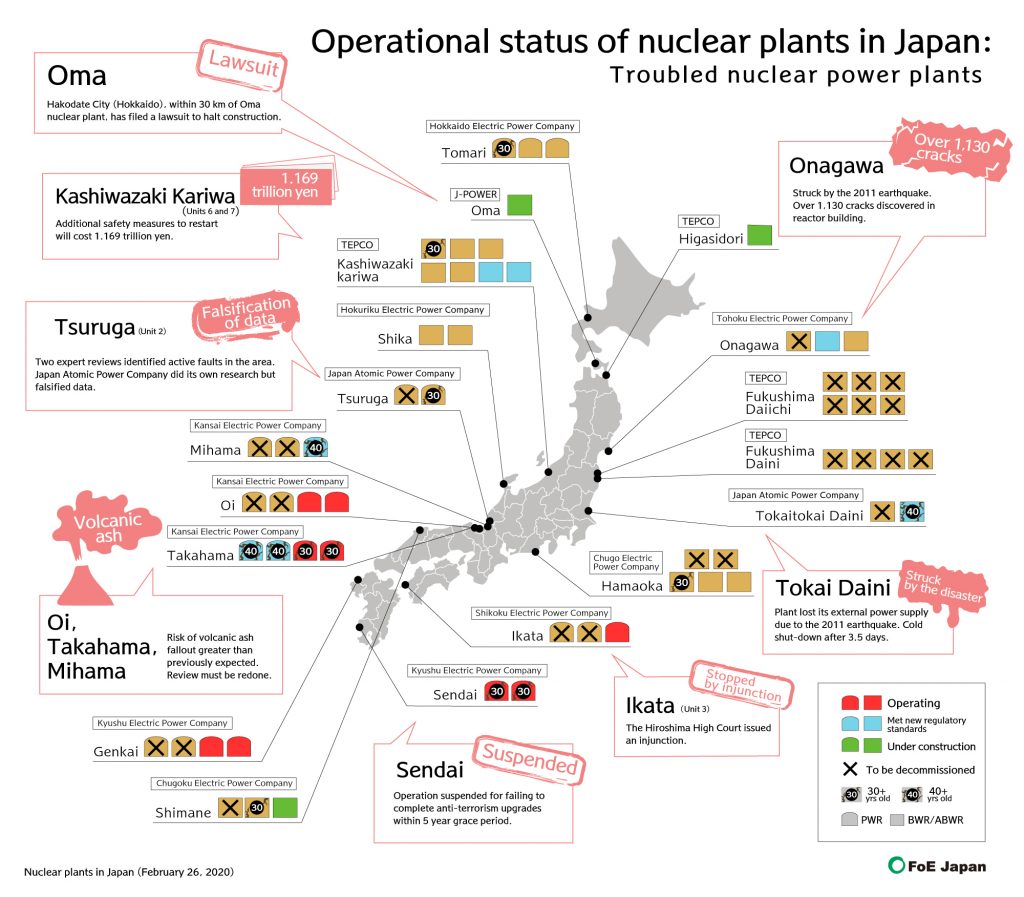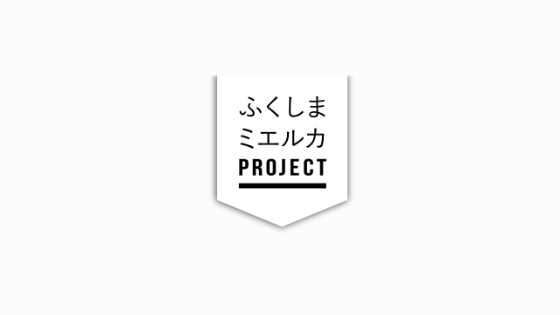9 reactors set to restart but…
Before the disaster at Fukushima Daiichi Nuclear Power Plant, there were 54 nuclear reactors in Japan. After the disaster, all nuclear power plants owned by TEPCO and Tohoku Electric Power Company were shut down, and for the past ten years, “nuclear-free” status has continued in Eastern Japan.
The Nuclear Regulation Authority (NRA) was established in September 2012. New regulatory standards were established in July 2013, requiring electric power companies to undergo inspections by the NRA before restarting nuclear power plants. Since the shutdown of Units 3 and 4 at Oi Nuclear Power Plant, nuclear power plants across Japan have been shut down for almost two years, resulting in a nuclear energy free period. As of February 10, 2021, a total of nine nuclear reactors have passed the regulatory standard inspections and have restarted operations: Sendai Nuclear Power Plant Units 3 and 4, Genkai Nuclear Power Plant Units 3 and 4, Ikata Nuclear Power Plant Unit 3, Oi Nuclear Power Plant Units 3 and 4, and Takahama Nuclear Power Plant Units 3 and 4.
Of these, only four nuclear reactors are actually in operation as of February 10, 2021.
The four reactors at Sendai and Takahama Nuclear Power Plants, which had once been restarted, were forced to shut down in 2020 due to delays in the construction of anti-terrorism facilities (Specialized Safety Facilities)(*1). The Sendai Power Plant has since recommenced its operations. Ikata Nuclear Power Plant’s Unit 3, which is undergoing periodic inspections, cannot resume operation even after the inspections are completed due to a decision by the Hiroshima High Court to halt operations. In addition, on December 4, the Osaka District Court ruled in favor of the residents in their lawsuit against Kansai Electric Power Company’s Oi Nuclear Power Plant Units 3 & 4, in which the residents demanded that the government revoke the reactor installation license. However, it has not been decided that the decision to grant permission for installation is that of the national governments meaning that operations of Oi Nuclear Power Plant will not be halted immediately(*2), but this could affect nuclear power plants across Japan moving forward. In 2019 and 2020, the number of nuclear power plants that newly restarted operations was zero. The share of nuclear power in total power generation, which was approximately 30% before the disaster, is now estimated to be around 6.5% as of 2019 (*3).

Kashiwazaki-Kariwa Nuclear Power Plant – TEPCO’s “Qualifications” Questioned
The cost of safety measures to restart operations at Unit 6 and 7 of TEPCO’s Kashiwazaki-Kariwa Nuclear Power Plant in Niigata Prefecture has rocketed up to 1.169 trillion yen. The Niigata Prefectural Government is currently examining three aspects of the plant: “the causes of the accident at the Fukushima Daiichi Nuclear Power Plant,” “the impact the disaster had on health and daily life,” and “safe evacuation methods.” Niigata Prefecture has stated that it will not discuss the restart of the plant until this process is completed.
At the same time, TEPCO’s “qualifications” to operate the plant were questioned during the inspection of the Kashiwazaki-Kariwa Plant. The Nuclear Regulation Authority (NRA) subjected the company to respond under the name of the company’s president, stating its “readiness to decommission the plant” and its “commitments towards continuous efforts to reduce risks,” which were also included in the safety regulations upon the NRA’s request. However, TEPCO has been reluctant to pay compensations to the residents and continues to reject the settlement proposal from the ADR (Atomic Energy Damage Dispute Resolution Center). The stance of the NRA is questionable as well. With just the inclusion of the above text (which has no substantial basis) into the safety regulations, the NRA granted the power plant in question a passing grade.
In February 2021, it was discovered that an employee of TEPCO’s Kashiwazaki-Kariwa Nuclear Power Plant used another employee’s ID card to gain unauthorized access into the plant’s central control room. It took the NRA four months to bring this fact to light, despite being aware that the incident took place. The attitude of not only TEPCO, but also that of the Nuclear Regulation Authority and the Regulatory Commission is in question.
Disaster-stricken Onagawa Nuclear Power Plant Unit 2 Passes Inspection – Governor quickly “agrees” to restart operations at the plant
Unit 2 of Tohoku Electric Power Company’s Onagawa Nuclear Power Plant (Miyagi Prefecture) received approval of changes of nuclear installation by the Nuclear Regulation Authority in February 2020. In October of the same year, the assemblies of Onagawa Town and Ishinomaki City, the municipalities where the plant is located, as well as the Miyagi Prefectural Assembly agreed to restart the plant. In November, Governor Murai of Miyagi Prefecture also agreed to restart the plant. There are still procedures to be completed, including approval of the construction plan and safety regulations, but Tohoku Electric is aiming to start operations in 2022.
At the time of the Great East Japan Earthquake, the Onagawa Nuclear Power Plant was hit by a 13-meter high tsunami and experienced strong tremors from the earthquake. Only one of the five external power lines was left intact, managing to keep the external power supply on. Many of the facilities and equipment were damaged. A total of 1,130 cracks were found in the earthquake-resistant walls of the reactor building.
Opposition to restarting operations remains strong within the prefecture. A Kahoku Shimpo poll from August 2017 showed that 68.6% of respondents were either “opposed” or “somewhat opposed” to the restart of Onagawa Nuclear Power Plant’s Unit 2. In February 2019, “The Association for the Realization of a Prefectural Referendum to Collectively Decide Whether or Not to Restart Onagawa Nuclear Power Plant” submitted 110,000 signatures to the prefectural assembly calling for the enactment of a prefectural referendum ordinance regarding the restart of the Onagawa Nuclear Power Plant, but it was rejected in March of the same year. The hasty agreement by the local government and the prefectural Governor to restart the plant has left the deep-rooted opposition movement up in the air.
1* The anti-terrorism facility is included in the New Regulatory Standards and should have been constructed before the restart of the plant, but an extension was granted, stating that they should “be installed within five years after the approval of the construction plan.”
2* It has been decided that Oi Nuclear Power Plant’s Unit 1 & 2 will be decommissioned. Damage has been found in the piping of Unit 3, and no timetable has been set for its restart. The Unit 4 restarted on January 15, 2021.
3* “Share of Renewable Energy Electricity, 2019 (Preliminary Report)” https://www.isep.or.jp/archives/library/12541
(“Fukushima Today and Japan’s Energy Future 2021”)

